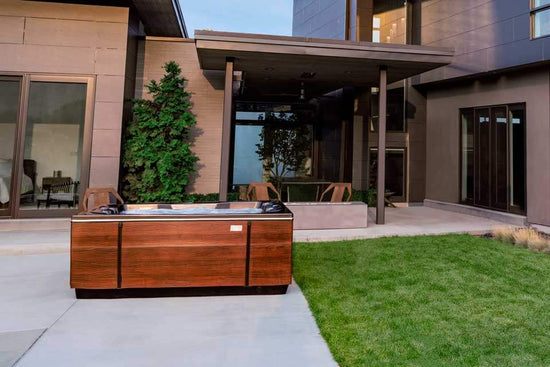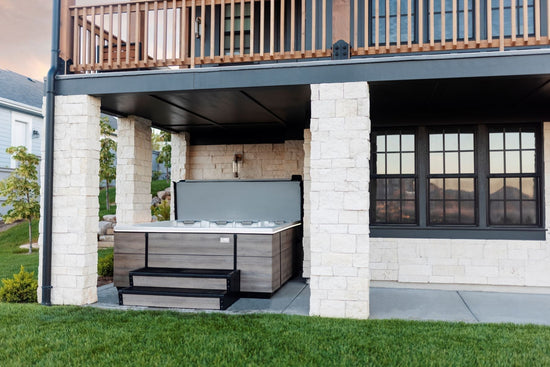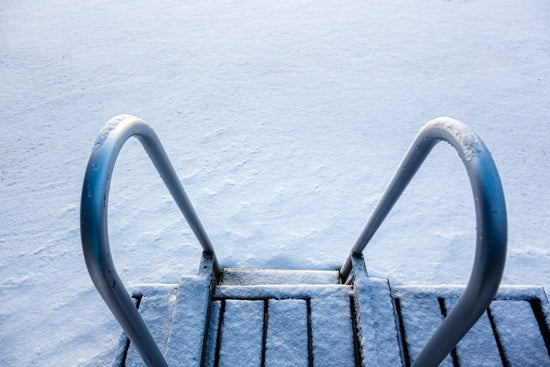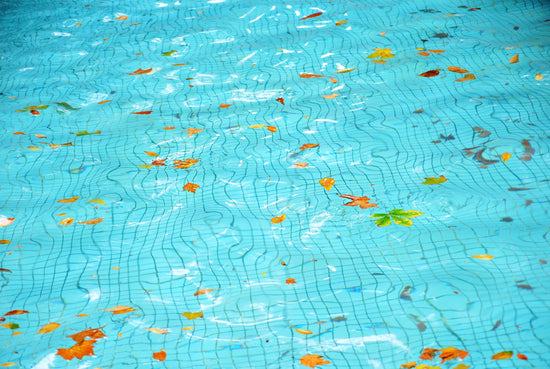Why is it essential to winterize your spa?
Properly winterizing your spa is crucial to avoid high costs for repairs and replacement parts. An effective winterization method protects your spa from damage caused by freezing temperatures, especially to plumbing lines, which can be particularly vulnerable in winter. By following simple steps to winterize your hot tub, you can save money and ensure the longevity of your equipment.
1. Gather Essential Accessories and Products to Winterize Your Spa
To effectively winterize your spa, it is crucial to have the right accessories and cleaning products. Here are the essential elements to prepare your spa for winter:
- Super Mechanical Sanitizer : Use Mineraluxe Cleanse & Drain to deep clean the internal components of your spa.
- Submersible Pump and Drainage Hose : Check out our collection to find the equipment needed for complete water evacuation.
- Wet Shop Vacuum: A ShopVac is essential to remove the last traces of water remaining in the spa.
- Ultra-Powerful Blower: Contact Piscine Hippocampe to rent an ultra-powerful blower, essential for evacuating all residual humidity. Rental available.
- Filter Cleaner : Mineraluxe Filter Revive is recommended to keep your filters in excellent condition.
- Shell and Cover Cleaner : Use Dazzle Surface Cleanse to effectively clean your spa shell and cover.
- Pipe Antifreeze : Apply Premium Dazzle Antifreeze with propylene glycol to protect pipes from freezing.
By making sure you have all of these products and equipment, you will facilitate the process of winterizing your spa and help protect it during the winter months.

2. Major Cleaning to Winterize Your Spa
Cleanse & Drain is specially formulated to deep clean your spa plumbing by removing the buildup of organic waste. For effective winterization, it is recommended to use this product 24 hours before completely draining your spa. Contaminants, such as biofilms, can build up in the circulation system and filters, affecting the spa's performance. While systems equipped with Mineraluxe generally reduce the need for such treatments, it is strongly recommended to perform this step before winterization.
How to Do the Big Clean:
- Keep Temperature High: Make sure the water temperature remains high during the cleaning process.
- Remove the Filter Cartridges: Remove the filter cartridges to prevent them from being damaged by the product.
- Apply the Product: Pour Cleanse & Drain directly into the spa water.
-
Run the Pump: Run the pump 3 to 5 times during the soaking process, alternating in 5 minute intervals. Make sure that:
- Bypass valves are in neutral position.
- All jets are operational (air cut off).
- Waterfalls and other elements work.
Tip: If the foam gets out of control, turn off the spa's circuit breaker, cover it, and let it sit for a few hours before draining.
By following these major cleaning steps, you will effectively prepare your spa for winterization, ensuring optimal protection against winter damage.

3. Turn off the Spa for Safe Winterization
3. Turn off the Spa for Safe Winterization
To ensure proper and safe winterization of your spa, it is essential to completely disconnect it from the electrical supply. Follow these steps to turn off your spa:
- Unplug the Power Cord (for 110V models only): If your spa is a 110V model, remove the power cord from the outlet to ensure that no electricity flows to the spa . For 220V models, go directly to the next step.
- Press the Power Button: Make sure the spa is turned off by pressing the power button.
- Turn Off the Circuit Breaker: Locate and turn off the spa-dedicated circuit breaker in your electrical panel to shut off the electrical power.
By following these steps to turn off the spa, you not only ensure the safety of the equipment, but you also prepare your spa for efficient and worry-free winterization.

4. Drain Your Spa for Complete Winterization
To properly winterize your spa, it is crucial to empty it completely. Follow these steps to ensure effective draining:
Remove the Drain Plug: Remove the drain plug located at the bottom of your spa. Attach a garden hose to the drain port to direct water out of the spa. Make sure the other end of the hose is positioned in a suitable location to discharge approximately 400 gallons of water. Verify that the drainage area can hold this amount of water.
Let the Spa Drain: Let the spa drain naturally. If you want to speed up the process, use a submersible pump to drain the water faster. Monitor the pump regularly to prevent it from becoming exhausted and remember to remove the drain plug when you are no longer using the pump.
Speed up the Process: To empty the spa even faster, you can combine the use of the garden hose and the submersible pump.
It is normal for one or two centimeters of water to remain at the bottom of the spa after draining. Don't worry just yet; you will take care of this later during the final preparation for winterization.
By following these steps to drain your spa, you will ensure that you are effectively preparing your spa for winter, reducing the risk of damage from frozen water.

5. Completely Blow Out Your Spa for Effective Winterization
To properly winterize your spa, it is crucial to ensure that no traces of water remain in the system. Here are the recommended steps to completely blow out your spa:
Use Appropriate Blowers: Due to different spa designs, it is advisable to use appropriate blowers to remove remaining water. You can rent this equipment from our branches. Pair them with a ShopVac sweeper to vacuum up water running out of pipes.
For Bullfrog Spas with JetPaks: If you have a Bullfrog spa equipped with JetPaks, open all bottom valves on the JetPaks to allow water to drain from each JetPak while you drain the spa . Once the water is completely drained, close each JetPak valve to prevent any residual water from entering.
Vacuum Plumbing Lines: After opening the valves on the JetPaks, use the ShopVac vacuum to vacuum the plumbing lines. Place the vacuum nozzle on each spa jet to ensure all traces of water are removed. For increased security, it is recommended to repeat this operation a second time.
Following these steps to fully blow out your spa will ensure optimal preparation for winterization, reducing the risk of damage from frozen water.

Important Tips for Winterizing Your Spa
To effectively winterize your spa and avoid significant damage, follow these crucial tips:
Avoid Freezing Pipes: Leaving water in plumbing pipes during the winter can cause freezing, which can result in pipes cracking or bursting. It is essential that your spa, as well as all its components, be completely emptied before winter. Make sure no water remains in the system.
Use the Proper Blower: To ensure that all traces of water are removed, use a proper blower. Insert the blower hose into each drain, fitting, jet, and filter cavity. Blow on each spot for 10 to 15 seconds to expel water from the pipes and into the tub.
Repeat Process: Once you have blown the water out of the lines, repeat the process to ensure no water remains in the system. Careful checking is crucial to avoid freeze-related problems.
Understand the Components of Your Spa: Take the time to understand the different components of your spa and visualize the hydraulic water system. This will help you identify critical spots where water might collect and need special attention.
By following these tips for winterizing your spa, you minimize the risk of winter damage and ensure adequate preparation for optimal use when the warm season returns.
6. Remove and Clean the Filters to Completely Winterize Your Spa
To effectively winterize your spa, it is essential to remove and clean the filters before storage. Here's how to ensure your filters stay in good condition during the winter:
Remove Filters: Do not leave filters in place during the winter. Carefully remove them from your spa. It is important not to store dirty filters, as this can cause problems when you use your spa again.
Clean Deep: Use a regular filter cleaner to remove dirt. However, for a more thorough cleaning, especially if the filters will be stored for several weeks or months, we recommend soaking them in a specialty chemical for 24 hours or at least overnight.
Replace Damaged Filters: If your filters are too worn to clean properly, it is best to throw them away and replace them with new filters when you reopen your spa for next season.
Remove Residual Water: Once the filters are removed, be sure to empty any remaining water into the filter well. You can use a Shop-Vac, sponges or towels to remove any residual water.
Following these steps to remove and clean filters will ensure your spa is properly prepared for winter, helping to ensure quick, trouble-free commissioning when swimming season returns.

7. Should Antifreeze be Added When Winterizing a Spa?
When winterizing your spa, the question often arises: "Can you put antifreeze in a spa?" Although the use of antifreeze may be considered, it is crucial to determine whether it is actually necessary.
Antifreeze: Necessity or Option?
In principle, there is no need to add antifreeze to a hot tub if you have followed the winterization steps correctly. The goal is to remove all water from the system to prevent freezing, making the use of antifreeze unnecessary. By carefully draining the lines and removing every drop of water, you minimize the risk of freeze damage.-
When to Use Antifreeze?
If you are unsure whether your hot tub has completely shut down or are concerned that certain sections have not been adequately purged, adding antifreeze can serve as a safety measure. Pour propylene antifreeze, such as Dazzle Premium Antifreeze, into areas where you suspect residual water.- Small spas: 1 to 2 gallons of antifreeze
- Mid-sized spas: 3 to 4 gallons of antifreeze
- Large spas and swim spas: 5 to 6 gallons of antifreeze
Additional Security Measure
Antifreeze is not a miracle solution, but rather a precautionary measure for cases where it is difficult to guarantee a complete drain. By using it correctly, you add a layer of safety to prevent pipes from freezing during the winter.
In summary, although the use of hot tub antifreeze is generally not necessary if winterization is done correctly, it can provide additional peace of mind for sections where you are not sure that all the water has been eliminated.

8. Clean the Shell and Lid for Optimal Winterization
For a complete and effective winterization of your spa, it is crucial to carefully clean the shell and cover. Follow these steps to ensure your spa is ready for winter:
Clean the Inside of the Spa
Apply a specialized cleaner, such as Surface Cleanse, using a sponge or soft cloth. Be sure to rinse the surface well and dry completely with a clean towel. This step helps remove dirt and residue that could cause long-term problems.Protect the Outside of the Lid
To preserve the appearance and durability of your spa cover, clean and protect the exterior with a weather-resistant cleaning product, such as F10 Protection. This product helps maintain the color of the cover and protects it from damage caused by UV rays and weather conditions.Clean the Headrests
Don't forget to remove the headrests and clean the underside of these items. There may be standing water which, if not removed, could become moldy over the winter.
By properly cleaning and protecting your spa shell and cover, you not only ensure effective winterization, but also optimal preparation for the next season of use. This helps extend the life of your spa and ensures it is functioning properly when it reopens.

9. Add a Winter Cover and Foam Block for Complete Protection
To finalize the winterization of your spa and ensure its protection against harsh winter conditions, follow these essential steps:
Install a Winter Cover
A winter cover is crucial to protect your spa from winter weather. Choose a cover specifically designed for spas that resists extreme weather conditions, UV rays and debris. By completely covering your spa with this cover, you prevent the accumulation of snow, ice and debris, while reducing the risk of damage during the winter.Use a Foam Block to Support the Lid
To prevent the spa cover from sagging under the weight of snow, place a foam block on top of the cover. This block serves as support to evenly distribute weight and prevent potential damage from heavy snowfall. Make sure the foam block is large enough to cover the entire lid and is stable.
By adding a winter cover and using a foam block, you maximize the protection of your spa against severe winter conditions. These measures ensure that your spa will remain in excellent condition and ready for use once warmer temperatures return.






